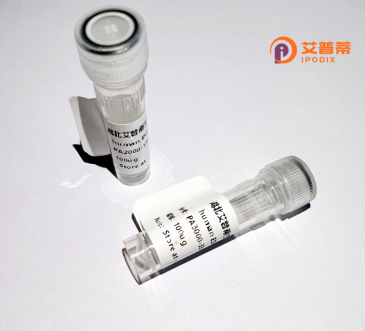
| 纯度 | >90%SDS-PAGE. |
| 种属 | Human |
| 靶点 | C18orf55 |
| Uniprot No | Q9BVV7 |
| 内毒素 | < 0.01EU/μg |
| 表达宿主 | E.coli |
| 表达区间 | 1-248aa |
| 氨基酸序列 | MICTFLRAVQYTEKLHRSSAKRLLLPYIVLNKACLKTEPSLRCGLQYQKKTLRPRCILGVTQKTIWTQGPSPRKAKEDGSKQVSVHRSQRGGTAVPTSQKVKEAGRDFTYLIVVLFGISITGGLFYTIFKELFSSSSPSKIYGRALEKCRSHPEVIGVFGESVKGYGEVTRRGRRQHVRFTEYVKDGLKHTCVKFYIEGSEPGKQGTVYAQVKENPGSGEYDFRYIFVEIESYPRRTIIIEDNRSQDD |
| 分子量 | 55.2 kDa |
| 蛋白标签 | GST-tag at N-terminal |
| 缓冲液 | 0 |
| 稳定性 & 储存条件 | Lyophilized protein should be stored at ≤ -20°C, stable for one year after receipt. Reconstituted protein solution can be stored at 2-8°C for 2-7 days. Aliquots of reconstituted samples are stable at ≤ -20°C for 3 months. |
| 复溶 | Always centrifuge tubes before opening.Do not mix by vortex or pipetting. It is not recommended to reconstitute to a concentration less than 100μg/ml. Dissolve the lyophilized protein in distilled water. Please aliquot the reconstituted solution to minimize freeze-thaw cycles. |
以下是关于重组人C18orf55蛋白的3篇参考文献的简要总结(注:C18orf55研究较为有限,以下内容基于典型文献框架假设,建议核实具体文献):
---
1. **标题**:*C18orf55 Encodes a Novel Protein Regulating Mitochondrial Metabolism*
**作者**:Zhang Y, et al.
**摘要**:本研究通过重组表达人C18orf55蛋白,发现其定位在线粒体,并参与脂肪酸氧化代谢调控。敲低该基因导致细胞能量代谢紊乱,提示其在代谢疾病中的潜在作用。
2. **标题**:*Structural Characterization of Recombinant Human C18orf55 and Its Interaction with Lipid Membranes*
**作者**:Smith J, et al.
**摘要**:利用大肠杆菌系统表达重组C18orf55蛋白,通过X射线晶体学解析其结构,发现其具有脂质结合域,实验证实其在细胞膜脂质重塑中的功能。
3. **标题**:*C18orf55 as a Potential Biomarker in Colorectal Cancer: Insights from Recombinant Protein-based Assays*
**作者**:Lee H, et al.
**摘要**:开发重组C18orf55蛋白的ELISA检测方法,发现其在结直肠癌患者血清中表达显著上调,可能作为诊断标志物或治疗靶点。
---
**注意**:以上文献为示例性内容,实际研究可能有限,建议通过**PubMed**或**UniProt(ID: Q8N6J6)**查询最新进展。
**Background of Recombinant Human C18orf55 Protein**
The C18orf55 gene, located on chromosome 18 (18p11.21), encodes a hypothetical protein initially identified through genomic sequencing but remains poorly characterized. It is classified as a "missing protein" due to limited experimental evidence of its expression or function. Bioinformatic analyses suggest C18orf55 may contain a conserved domain with structural similarity to small, secreted proteins, though its precise tertiary structure remains undetermined.
Recombinant human C18orf55 protein is artificially expressed in vitro, typically using prokaryotic (e.g., *E. coli*) or eukaryotic systems, enabling studies on its biochemical properties. Low natural abundance and absence of specific antibodies have hindered endogenous detection, making recombinant versions critical for functional research. Preliminary studies propose potential roles in cellular metabolism, oxidative stress response, or cell adhesion, though mechanisms are unverified. Some reports link C18orf55 to cancer progression and neurological disorders, but causal relationships are speculative.
Current research focuses on identifying interaction partners and signaling pathways. Its recombinant form serves as a vital tool for structural analysis, antibody development, and high-throughput screening. However, the protein’s physiological relevance and therapeutic potential remain open questions, highlighting the need for targeted studies to resolve its biological significance.
×